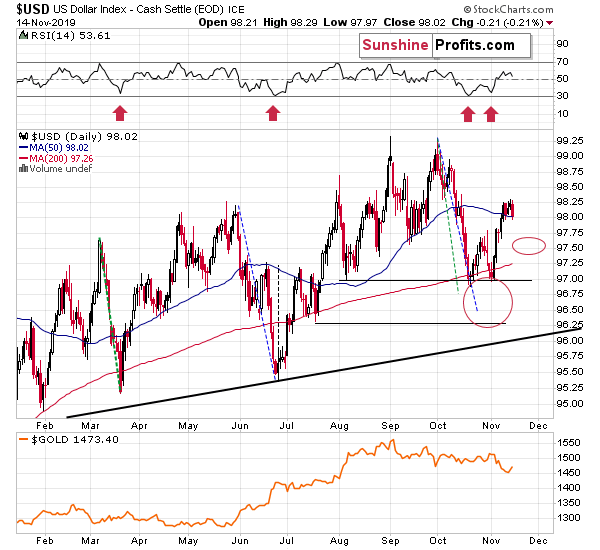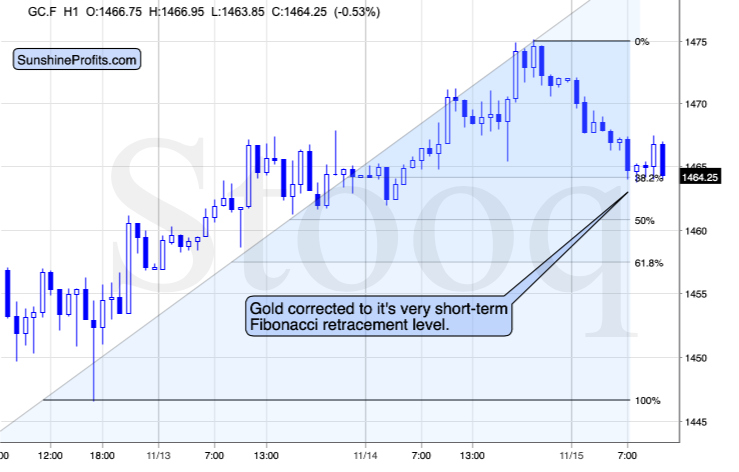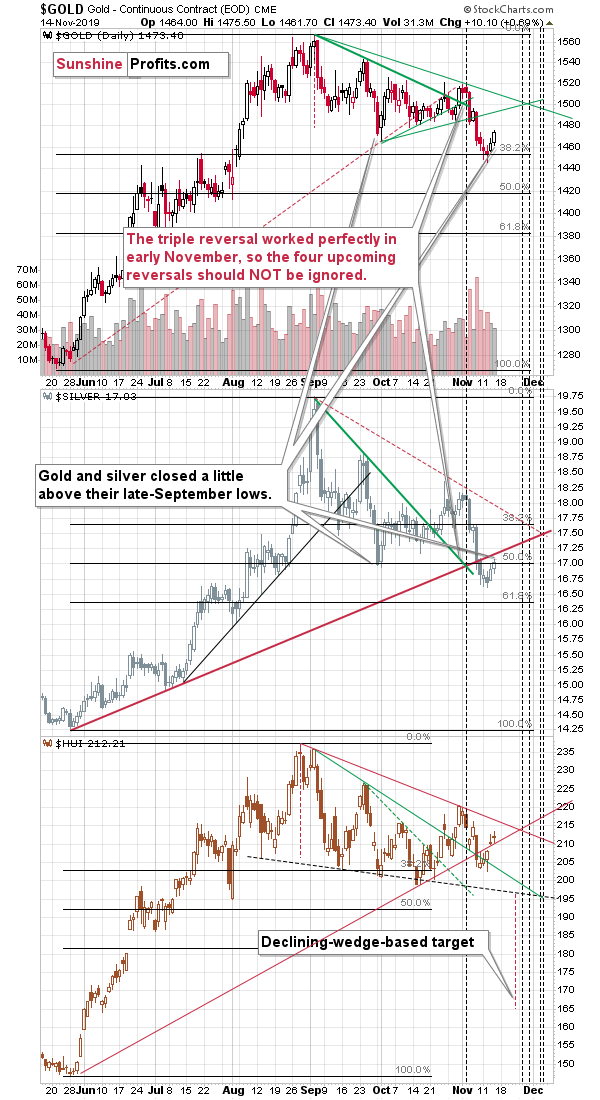Briefly: in our opinion, small (50% of the regular size of the position) speculative long position in gold, silver, and mining stocks are justified from the risk/reward point of view at the moment of publishing this Alert.
In yesterday's analysis, we wrote about the likely breakdown below the rising wedge pattern in the USD Index, the decline that was likely to follow, and the rally in gold and silver that was likely to emerge as a result. It all materialized in the above-mentioned way, but today's pre-market trading saw gold and silver moving lower, so you're probably wondering if the rally is already over.
In our view, it's not likely. Not yet.
First, let's take a look at the USD Index.
Is the USD Index Done Declining?
The breakdown below the very short-term rising wedge pattern resulted in a major decline. "Major" from the very short-term point of view as it's been the biggest daily decline that we saw this month. Apart from that, it was not very significant. The USDX closed right at its 50-day moving average without breaking below it, which is probably why the decline wasn't deeper. The 50-day MA has been providing support quite reliably in the previous months. It was not always strong support, but often meaningful enough to make it useful as a trading tool. It stopped the decline yesterday, but we continue to think that the index will still move lower, just as it did in two previous cases this year.
The green and blue dashed lines represent declines that are similar to the October decline. The rallies that followed them were quite sharp, but they too had smaller pauses within them. Both: March-April, and July rallies consolidated after the USDX moved above its 50-day moving average.
The short-term decline that we saw so far is too little compared to what we saw in early April and in mid-June. Consequently, the odds are that the USD Index will decline some more before soaring to new highs.
This means that gold is likely to move higher before plunging.
- If that's so, then why did gold decline in overnight trading?
No market can move up or down in a straight line and it's true not only in case of the big, long- or medium-term moves, but also in case of the immediate-term price swings. Gold corrected to its 38.2% Fibonacci retracement level after a 2-day rally, then it bounced and went on to decline a bit more. That's relatively normal and nothing to be concerned about. The very short-term outlook remains bullish. If gold breaks below the 61.8% Fibonacci retracement level ($1457), the above might change, but that's not the case so far.
Interestingly, both gold and silver invalidated their previous breakdowns in terms of the daily closing prices.
PMs Turning Higher
Both precious metals closed slightly (but still) above their lowest closing prices of September. Silver didn't move back above the rising red support/resistance line, but the breakdown below the previous low was invalidated.
The resistance provided by the lows is a good reason why gold and silver corrected today. But, just as the decline in the USDX doesn't seem to be over, the rally in gold and silver seems to have more upside.
Before summarizing... Do you recall the early-November turnaround, and in particular, what clearly indicated it? It was the triple reversal based on the triangle-vertex-reversal technique. This useful technique is providing us with new indications. The reversal dates are not so perfectly aligned this time as they were about 2 weeks ago, but they are not very far from each other either.
Based on the dates when support and resistance lines cross, we get four separate reversal time targets, but they are relatively close to each other. The common denominator here is the turn of the month. Two reversals point to the very end of November and two are coming very early in December. This means that we might see relatively choppy trading at this time.
It might also mean that different parts of the precious metals sector will top at different times. The first reversal is in the mining stocks, which would be quite normal - miners tend to rally sooner than gold and silver. The last reversal is in silver, which would also be normal - the white metal usually catches up with the rest of the PM market close to the end of a given upswing. This phenomenon can be extremely useful in case of long-term investments, by the way.
The latter interpretation seems more likely, but we would like to emphasize that it's not carved in stone. As we move closer to the end of the month, we will know what gold, silver, and miners are doing and thus we will be able to fine-tune our expectations regarding the vertex-based reversals. Definitely, we'll keep you - our subscribers - informed.
Naturally, the key bearish factors for the medium term remain intact - the outlook became bullish only for the short term.
Key Factors to Keep in Mind
Critical factors:
- The USD Index broke above the very long-term resistance line and verified the breakout above it. Its huge upswing is already underway.
- The USD's long-term upswing is an extremely important and bearish factor for gold. There were only two similar cases in the past few decades, when USD Index was starting profound, long-term bull markets, and they were both accompanied by huge declines in gold and the rest of the precious metals market
- Out of these two similar cases, only one is very similar - the case when gold topped in February 1996. The similarity extends beyond gold's about a yearly delay in reaction to the USD's rally. Also the shape of gold price moves prior to the 1996 high and what we saw in the last couple of years is very similar, which confirm the analysis of the gold-USD link and the above-mentioned implications of USD Index's long-term breakout.
- The similarity between now and 1996 extends to silver and mining stocks - in other words, it goes beyond USD, gold-USD link, and gold itself. The white metal and its miners appear to be in a similar position as well, and the implications are particularly bearish for the miners. After their 1996 top, they erased more than 2/3rds of their prices.
- Many investors got excited by the gold-is-soaring theme in the last few months, but looking beyond the short-term moves, reveals that most of the precious metals sector didn't show substantial strength that would be really visible from the long-term perspective. Gold doesn't appear to be starting a new bull market here, but rather to be an exception from the rule.
- Gold stocks appear to be repeating their performance from 20 years ago, which means that a bottom in the entire precious metals sector is quite likely to form at much lower prices, in about a year
Very important, but not as critical factors:
- Long-term technical signs for silver, i.a. the analogy in terms of price to what we saw in 2008, shows that silver could slide even below $10.
- Silver's very long-term cycles point to a major reversal taking place right now and since the most recent move was up, the implications are bearish (this is also silver's technical sign, but it's so important that it deserves its own point)
- Long-term technical signs for gold stocks point to this not being a new gold bull market beginning. Among others, it's their long-term underperformance relative to gold that hint this is rather a corrective upswing within a bear market that is not over yet.
- Record-breaking weekly volume in gold is a strong sign pointing to lower gold prices
Important factors:
- Extreme volume reading in the SIL ETF (proxy for silver stocks) is an effective indication that lower values of silver miners are to be expected
- Silver's short-term outperformance of gold, and gold stocks' short-term underperformance of gold both confirm that the precious metals sector is topping here
- Gold topped almost right at its cyclical turning point, which makes the trend reversal more likely
- Copper broke below its head-and-shoulders pattern and confirmed the breakdown. The last time we saw something similar was in April 2013, when the entire precious metals sector was on the verge of plunging lower.
Moreover, please note that while there may be a recession threat, it doesn't mean that gold has to rally immediately. Both: recession and gold's multi-year rally could be many months away - comparing what happened to bond yields in the 90s confirms that.
Summary
Summing up, the outlook for the precious metals sector remains very bearish for the following months, but it seems that we will first see a short-term upswing before the decline continues. Based on what we saw in the last two days, the bullish outlook is even more justified. Today's pre-market decline seems to be just a quick correction within a short-term rally. We expect to close the current long position relatively soon and open another short position at that time - so that we're once again positioned to gain from the main trend, which remains down. We expect to close the long position within the next 1-3 weeks, but it might be sooner, for instance should we see a sharp rally and a reversal shortly.
As always, we'll keep you - our subscribers - informed.
To summarize:
Trading capital (supplementary part of the portfolio; our opinion): Small speculative long position (50% of the full position) in gold, silver, and mining stocks is justified from the risk/reward perspective with the following stop-loss orders and binding exit profit-take price levels:
- Gold: profit-take exit price: $1,489.80; stop-loss: $1,437; initial target price for the UGLD ETN: $135.88; stop-loss for the UGLD ETN: $122.10
- Silver: profit-take exit price: $17.47; stop-loss: $16.27; initial target price for the USLV ETN: $89.33; stop-loss for the USLV ETN: $72.44
- Mining stocks (price levels for the GDX ETF): profit-take exit price: $27.88; stop-loss: $25.47; initial target price for the NUGT ETF: $30.27; stop-loss for the NUGT ETF $23.08
In case one wants to bet on junior mining stocks' prices, here are the stop-loss details and target prices:
- GDXJ ETF: profit-take exit price: $39.27; stop-loss: $35.38
- JNUG ETF: profit-take exit price: $67.97; stop-loss: $49.83
Long-term capital (core part of the portfolio; our opinion): No positions (in other words: cash)
Insurance capital (core part of the portfolio; our opinion): Full position
Whether you already subscribed or not, we encourage you to find out how to make the most of our alerts and read our replies to the most common alert-and-gold-trading-related-questions.
Please note that the in the trading section we describe the situation for the day that the alert is posted. In other words, it we are writing about a speculative position, it means that it is up-to-date on the day it was posted. We are also featuring the initial target prices, so that you can decide whether keeping a position on a given day is something that is in tune with your approach (some moves are too small for medium-term traders and some might appear too big for day-traders).
Plus, you might want to read why our stop-loss orders are usually relatively far from the current price.
Please note that a full position doesn't mean using all of the capital for a given trade. You will find details on our thoughts on gold portfolio structuring in the Key Insights section on our website.
As a reminder - "initial target price" means exactly that - an "initial" one, it's not a price level at which we suggest closing positions. If this becomes the case (like it did in the previous trade) we will refer to these levels as levels of exit orders (exactly as we've done previously). Stop-loss levels, however, are naturally not "initial", but something that, in our opinion, might be entered as an order.
Since it is impossible to synchronize target prices and stop-loss levels for all the ETFs and ETNs with the main markets that we provide these levels for (gold, silver and mining stocks - the GDX ETF), the stop-loss levels and target prices for other ETNs and ETF (among other: UGLD, DGLD, USLV, DSLV, NUGT, DUST, JNUG, JDST) are provided as supplementary, and not as "final". This means that if a stop-loss or a target level is reached for any of the "additional instruments" (DGLD for instance), but not for the "main instrument" (gold in this case), we will view positions in both gold and DGLD as still open and the stop-loss for DGLD would have to be moved lower. On the other hand, if gold moves to a stop-loss level but DGLD doesn't, then we will view both positions (in gold and DGLD) as closed. In other words, since it's not possible to be 100% certain that each related instrument moves to a given level when the underlying instrument does, we can't provide levels that would be binding. The levels that we do provide are our best estimate of the levels that will correspond to the levels in the underlying assets, but it will be the underlying assets that one will need to focus on regarding the signs pointing to closing a given position or keeping it open. We might adjust the levels in the "additional instruments" without adjusting the levels in the "main instruments", which will simply mean that we have improved our estimation of these levels, not that we changed our outlook on the markets. We are already working on a tool that would update these levels on a daily basis for the most popular ETFs, ETNs and individual mining stocks.
Our preferred ways to invest in and to trade gold along with the reasoning can be found in the how to buy gold section. Additionally, our preferred ETFs and ETNs can be found in our Gold & Silver ETF Ranking.
As a reminder, Gold & Silver Trading Alerts are posted before or on each trading day (we usually post them before the opening bell, but we don't promise doing that each day). If there's anything urgent, we will send you an additional small alert before posting the main one.
=====
Latest Free Trading Alerts:
In a key policy shift, the ECB has recently introduced tiered system of interest rates. This news isn't of interest only to the banks keeping their reserves at the ECB. In today's article, you'll learn about the new instrument of monetary policy, and find out what it implies for the gold market.
What ECB's Tiering Means for Gold
=====
Thank you.
Sincerely,
Przemyslaw Radomski, CFA
Editor-in-chief, Gold & Silver Fund Manager






